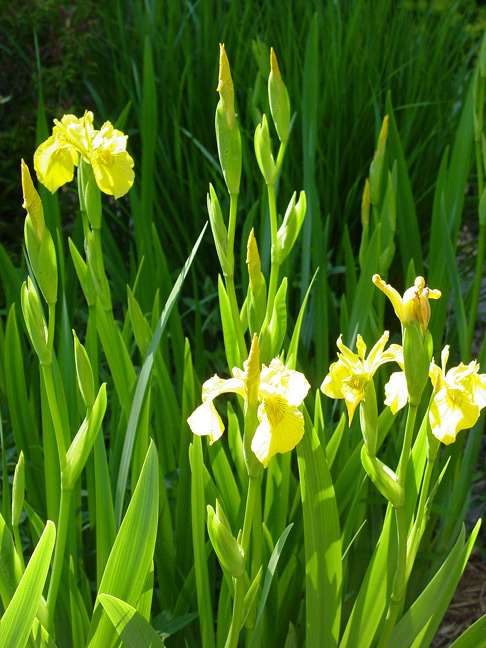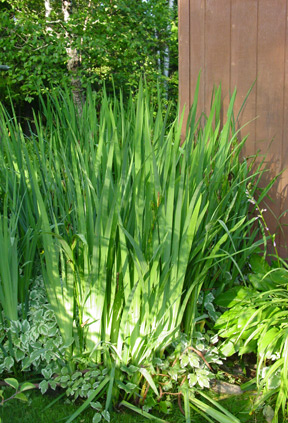A few years ago, after admiring the Yellow Flag Iris (Iris Pseudacorus) in my sister’s garden, she gave me a couple of small plants to try in our yard. Her Pseudacorus had sword-like clumps that were 5-6 feet tall, looked very dramatic and bloomed with showy yellow flowers each summer. I wanted to try them around my arbor to provide both summer color and privacy to our outdoor dining area. My plants grew quickly and I soon learned to remove the seed pods when my iris had finished blooming to prevent hundreds of baby iris being planted. I liked my Pseudacorus, but did not want a whole colony of them.
Eventually I moved 3 separate clumps of yellow flag iris to a new spot where they function as a tall and dramatic background in my front garden. An interesting fact about flag iris is that they respond dramatically to the moisture level in the garden. When this plant gets plenty of water, it grows to its full height of 5-6 feet. However in a dry year, if I neglect to water, they top out at 2-3 feet. Even then, they still bloom and look attractive, albeit much shorter and less showy.
Research
Yellow flag iris (Iris Pseudacorus) is a good looking wetland perennial that is native to Europe, the British Isles, North Africa and Mediterranean region but is not native to the United States. Over the years it has been transplanted into well-watered gardens all over the world and has widely escaped by sending seeds downstream from the original gardens.
Habitat: Yellow flag iris does best along stream beds, near ponds, and in marshes. It is fast growing and colonizes in large numbers forming dense stands that crowd out many native plants and changes wildlife habitat. In some areas this has become a real problem so yellow flag iris has often been classified as an invasive weed.
Uses for Yellow flag iris: The root can be used in herbal remedies, including a cure for toothache, diarrhea, and cramps among many others. A drink “similar to coffee” can be brewed from the seeds, and dyes of yellow and black can be made from the flowers and roots respectively. Flag iris is also used in sewage treatment, because it is able to remove metals from waste waters.
I like this plant and think it is a great addition to my perennial bed. However, I do see the wisdom of containing it in the garden and not planting it near rivers and streams where it can escape.






What a nice write up of one of my favorite plants! I didn’t know the bit about its use in sewage treatment.